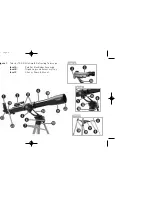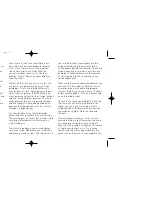
object to observe the first time you go
out at night. Pick a night when the
Moon is a crescent. No shadows are
seen during a full Moon, making it
appear flat and uninteresting.
Look for different features on the Moon. The
most obvious features are craters. In fact
you can see craters within craters. Some
craters have bright lines about them. These
are called rays and are the result of material
thrown out of the crater when it was struck
by a colliding object. The dark areas on the
Moon are called maria and are composed of
lava from the period when the Moon still had
volcanic activity. You can also see mountain
ranges and fault lines on the Moon.
Use a neutral density filter (often called a
“moon filter”) when observing the Moon.
Neutral density filters are available from
Meade as an optional accessory and
enhance contrast to improve your
observation of lunar features.
Spend several nights observing the Moon.
Some nights, the Moon is so bright that it
makes other objects in the sky difficult to
see. These are nights that are excellent for
lunar observation.
Observe the Solar System
: After observing
the Moon, you are ready to step up to the
next level of observation, the planets. There
are four planets that you can easily observe
in your telescope: Venus, Mars, Jupiter
and Saturn.
Nine planets (maybe more!) travel in a fairly
circular pattern around our Sun. Any system
of planets orbiting one or more stars is
called a solar system. Our Sun, by the way,
is a single, yellow dwarf star. It is average as
far as stars go and is a middle aged star.
6
TOO MUCH POWER?
Can you ever have too much power? If the type of
power you’re referring to is eyepiece magnification,
yes you can! The most common mistake of the
beginning observer is to “overpower” a telescope
by using high magnifications which the telescope’s
aperture and atmospheric conditions cannot
reasonably support. Keep in mind that a smaller,
but bright and well-resolved image is far superior
to one that is larger, but dim and poorly resolved.
Powers above 400x should be employed only under
the steadiest atmospheric conditions.
Beyond the planets are clouds of comets, icy
planetoids and other debris left over from
the birth of our sun. Recently astronomers
have found large objects in this area and
they may increase the number of planets in
our solar system.
The four planets closest to the Sun are rocky
and are called the inner planets. Mercury,
Venus, Earth and Mars comprise the inner
planets. Venus and Mars can be easily seen
in your telescope.
Venus is seen before dawn or after sunset,
because it is close to the Sun. You can
observe Venus going through crescent
phases. But you cannot see any surface
detail on Venus because it has a very thick
atmosphere of gas.
When Mars is close to the Earth, you can see
some details on Mars, and sometimes even
Mars’ polar caps. But quite often, Mars is
further away and just appears as a red dot
with some dark lines crisscrossing it.
Jupiter, Saturn, Uranus, Neptune and Pluto
comprise the outer planets. These planets,
except for Pluto, are made mostly of gases
Telestar RB-70.qxd 10/15/08 3:23 PM Page 8
Содержание TELESTAR RB-70
Страница 1: ...N MANUAL fracting Telescope RB 70 M Page 1...
Страница 2: ...M Page 2...
Страница 15: ...or eries n a of an re 13 TY ies l nd M Page 15...
Страница 17: ...ENT GOOD POOR DRAWING OF IMAGE SAVE ORIGINAL BE SURE TO MAKE COPIES RVATION LOG M Page 17...
Страница 18: ...ENT GOOD POOR DRAWING OF IMAGE RVATION LOG M Page 18...
Страница 19: ...M Page 19...
Страница 20: ...www meade com Meade Instruments Corporation 6001 Oak Canyon Irvine California 92618 0 626 3233 M Page 20...


























